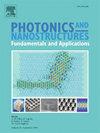高近红外屏蔽性能节能窗的机器学习辅助设计
IF 2.5
3区 物理与天体物理
Q3 MATERIALS SCIENCE, MULTIDISCIPLINARY
Photonics and Nanostructures-Fundamentals and Applications
Pub Date : 2025-04-18
DOI:10.1016/j.photonics.2025.101389
引用次数: 0
摘要
基于氧化铯钨(CWO)和氧化铟锡(ITO)纳米颗粒的纳米复合膜由于其独特的近红外吸收特性,为节能窗光学性能的调整提供了广阔的空间。这一特性引起了人们对这种材料的节能窗户领域的极大研究兴趣。节能窗的光学特性主要由纳米粒子的局域表面等离子体共振(LSPR)决定,因此对纳米粒子几何参数的变化非常敏感。通常,特定光学特性的设计和几何参数的迭代优化的计算成本是昂贵和耗时的。在本研究中,我们将机器学习和辐射传递计算相结合,以实现有针对性的节能窗户设计。通过调整纳米颗粒的形状、材料和几何参数,可以建立纳米颗粒几何参数对节能窗性能的分析模型。然后,建立了双向深度神经网络机器学习模型,实现了节能窗光学评价参数(可见光透过率(Tlum)、近红外透过率(TNIR)、太阳辐射透过率(Tsol)和优值图(FOM))的准确预测,以及纳米颗粒(CWO和ITO)几何参数的逆设计。结果表明,我们的机器学习模型实现了节能窗光学特性的正向预测,精度超过99 %,几何参数的逆设计精度超过93 %。总的来说,这项工作为评估和设计节能窗户的性能提供了一种广泛适用且计算效率高的方法。本文章由计算机程序翻译,如有差异,请以英文原文为准。
Machine-learning-assisted design of energy-saving windows with high near-infrared shielding properties
Nanocomposite films based on Cesium tungsten oxide (CWO) and Indium tin oxide (ITO) nanoparticles provide a broad space for adjusting the optical properties of energy-saving windows due to their unique near-infrared absorption properties. This property has led to great research interest in the field of energy-saving windows for such materials. The optical properties of energy-saving windows are mainly determined by localized surface plasmon resonance (LSPR) of the nanoparticles, and thus they are sensitive to the variation of the geometrical parameters of the nanoparticles. Typically, the computational cost of the design of specific optical properties and iterative optimization of the geometrical parameters is expensive and time-consuming. In this study, we combine machine learning and radiative transfer calculations to achieve targeted design energy-saving windows. By adjusting the shape, material, and geometric parameters of nanoparticles, an analysis model can be established from the geometric parameters of nanoparticles to the properties of energy-saving windows. Then, a machine learning model of bidirectional deep neural network is developed to achieve accurate prediction of optical evaluation parameters (visible transmittance (Tlum), near-infrared (NIR) transmittance (TNIR), solar radiation transmittance (Tsol), and the Figure of Merit (FOM)) for energy-saving windows, as well as inverse design of geometric parameters of nanoparticles (CWO and ITO). The results indicate that our machine learning model achieved forward prediction of energy-saving window optical properties with an accuracy of over 99 % and inverse geometric parameter design with an accuracy of over 93 %. Overall, this work provides a broadly appropriate and computationally efficient method for evaluating and designing the properties of energy-saving windows.
求助全文
通过发布文献求助,成功后即可免费获取论文全文。
去求助
来源期刊
CiteScore
5.00
自引率
3.70%
发文量
77
审稿时长
62 days
期刊介绍:
This journal establishes a dedicated channel for physicists, material scientists, chemists, engineers and computer scientists who are interested in photonics and nanostructures, and especially in research related to photonic crystals, photonic band gaps and metamaterials. The Journal sheds light on the latest developments in this growing field of science that will see the emergence of faster telecommunications and ultimately computers that use light instead of electrons to connect components.

 求助内容:
求助内容: 应助结果提醒方式:
应助结果提醒方式:


